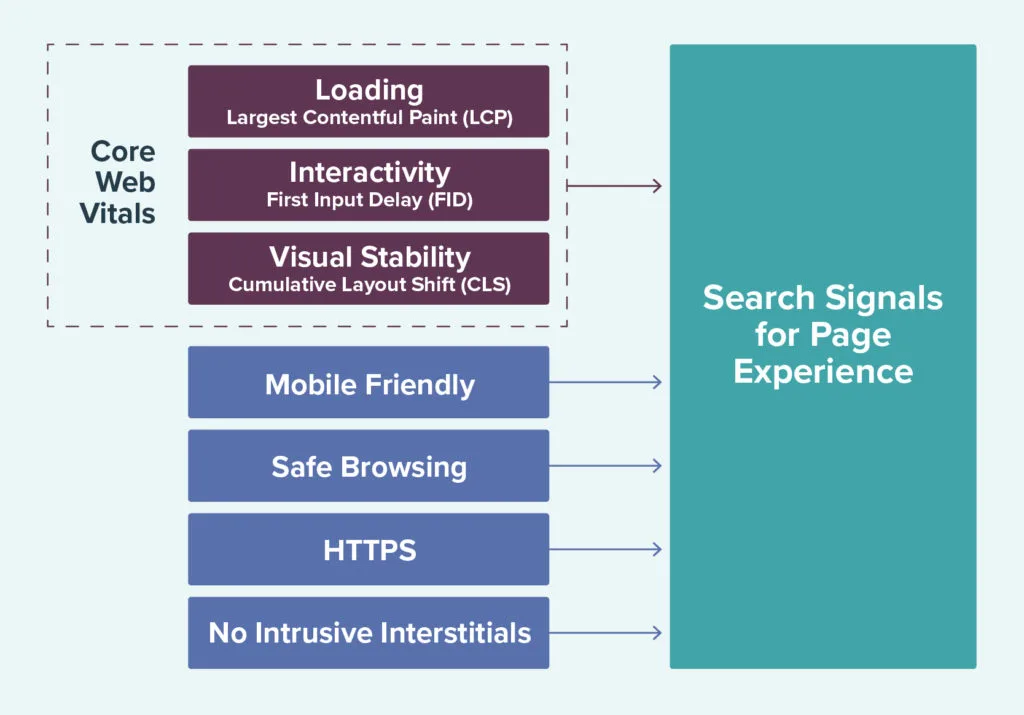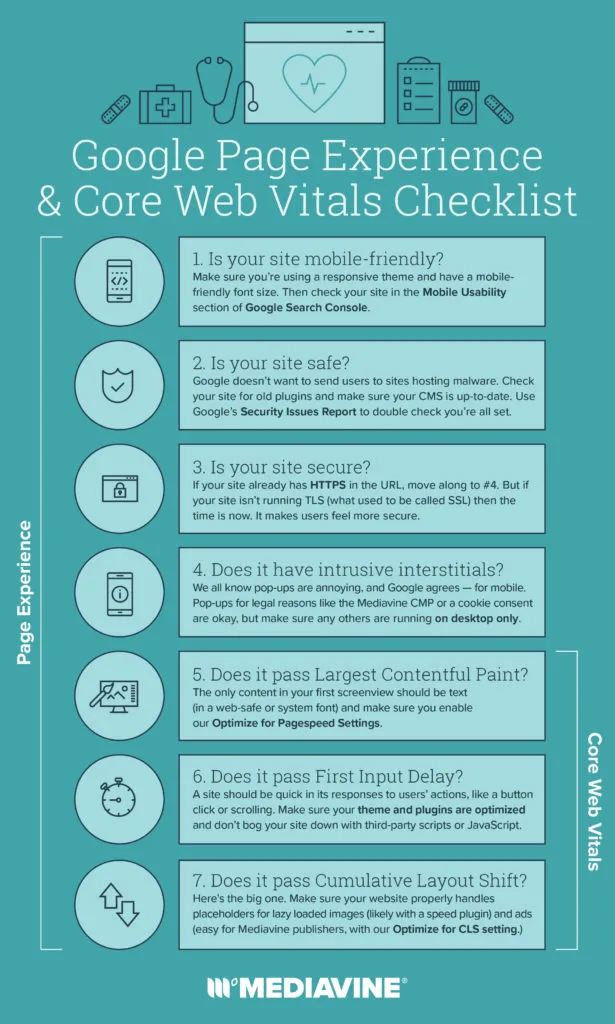Core Web Vitals: Google Page Experience Checklist For Bloggers


Updated 8/30/2021 – The Trellis Open Beta is now available to all! Turbocharge your WordPress site and conquer those Core Web Vital scores with the theme built for speed. Learn more or get Trellis now!
The much-discussed Google Page Experience update is set to hit next month (May 2021) and with it comes several new requirements, including the elusive Core Web Vitals.
Google’s Core Web Vitals are three new Page Experience requirements, all of which are crucial for publishers’ pagespeed and SEO performance. How crucial?
Not only will they help you improve search results across the board, but passing scores open up the possibility of appearing in previously AMP-only carousels. This is big.
What are Page Experience requirements and how do Core Web Vitals fit in?
Page Experience, overall, is a rebranding of sorts; Google has combined existing requirements with the new Core Web Vitals metrics that are all about pagespeed.
All of this is illustrated in the Page Experience chart below.
Let’s break down each component, along with what you need to do to set yourself up for success!

Ten years ago, making your site as mobile friendly as possible was a novel concept. In 2021, with a vast majority of readers using phones and tablets, it’s the new standard.
Google took its old ranking signal from 2015 (not quite a decade ago, but close) and packaged it as part of Page Experience. How is your site holding up?
If you have a responsive theme that does things like remove the sidebar and you’re using a mobile-friendly font size, you’re probably passing.
To make sure, put your homepage and a few of your articles to the Google Mobile-Friendly Test. There’s also the “Mobile Usability” section of Google Search Console that will make you aware of any errors your website might have.
Safe Browsing is another rebranding of a set of existing requirements, and in this case it signals that your website hasn’t been hacked and isn’t hosting malware.
To keep your site safe, make sure you keep your WordPress or CMS software and plugins updated. In general, be mindful of what you install.
Whether it’s a plugin or a piece of third-party JavaScript, such as an influencer badge, any of those things can lead to your site failing the Safe Browsing signal.
How do you know if you’re failing? The Security Issues Report will notify you and you’ll be able to fix any issues, although chances are good that if you’re careful with your plugins and scripts, you won’t need to worry about this one.
We’ve been pushing sites for years to go secure with SSL, and so has Google.
Having a secure site (with a valid TLS certificate and a url beginning with https://) has been a ranking factor with Google since 2014.
Yes, you read that right — it’s a seven-year-old algorithm getting a new name.
If somehow you’re not running TLS (or what you may have seen previously labeled as SSL), make sure you start from now on. It’s incredibly easy to tell, because Chrome will display a symbol in the search bar that visually informs a reader whether your site is “safe”, “not secure”, or even “dangerous”. Mediavine ads are SSL compatible so no worries there.
When you go to your site and look in the address bar, does it begin with https://? If so, you’re good to go with this one. Just make sure your website is also redirecting traffic requested with http:// to https:// and you’ll be fine. Your host should be able to help with this.
Publishers are likely familiar with this one; Google banned mobile interstitials back in 2016 on the basis that these experiences make web content less accessible.
That somewhat vague language has been debated over the years, but the basic guidance is this: no pop-ups covering the content when a user arrives on a page from a Google search result — unless it’s for legal reasons such as a cookie consent or the Mediavine CMP.
This signal is simply being renamed “No Intrusive Interstitials”. The same rules still apply as Google itself linked to the original guidance in its announcement.
No Intrusive Interstitials still applies to mobile, even if it’s not in the name. This is nothing new from 2016. To pass, either ditch pop-ups entirely or only run them on desktop or for users arriving from sources other than Google Search.

Finally, we come to Core Web Vitals, the new ranking signals and those representing actual changes. Google’s emphasis on pagespeed isn’t new, of course.
Google has been stressing the importance of pagespeed since 2010, so Core Web Vitals are just the latest, most specific iteration of this decades-long push.
The biggest change in May 2021 is that instead of vague requirements (faster is better!), there are now actual metrics to measure your website’s performance.
These are the Core Web Vitals, and they are a critical part of Page Experience.
For the first time, you can actually check your scores in Google Search Console and see if you’re “passing” these new requirements.
Initially, these may seem hard to hit, but we’re okay with that. At least there are clear goals, and a challenge beats vagueness or uncertainty any day.
Without further ado, let’s get to know your Core Web Vitals and three favorite new acronyms.
Largest Contentful Paint, or LCP, is the time it takes for the largest object in your first screenview (whether it’s a block of text or image) to load.
Whatever that largest element is, your goal is to make sure it loads in under 2.5 seconds.
How do you optimize for LCP? Well, it’s going to take some effort on the pagespeed front, but it’s also something you can use to your advantage.
In addition to the regular pagespeed advice Mediavine espouses, make sure you’re running a web safe or a system font, and if you can, make the largest element text instead of an image. You’ll be passing LCP in no time at all.
Also, make sure you’re running both our Optimize for Mobile and Desktop PageSpeed options in your Mediavine Dashboard. That will get the ads out of the way while your largest element is being “painted” (loading) and help you achieve optimal scores.
Please see our guide on how to optimize for LCP for more tips and advice.
First Input Delay, or FID, is a pagespeed metric measuring the time it takes a website to respond after a user’s first input — whether that’s clicking on a link, button, scroll, etc.
In effect, it’s a measurement of the interactivity of your site.
The best way to keep your site responding quickly to its readers is to reduce the JavaScript running on site or limit things tying up the main thread.
What the heck does that mean? Glad you asked.
Running fewer scripts overall, being mindful of what every script loads and making sure everything is deferred whenever possible is the key to success.
Running settings like Optimize Ads for PageSpeed for both Desktop and Mobile will help with FID from ads, but you’ll also need to have well-optimized plugins and a theme (have you met Trellis?) or a well-configured optimization plugin.
As always, reducing the sheer number of plugins and third-party scripts and monitoring those you do run is the best way to optimize for FID.
Keep your site light and fast!
Finally, the big one — even if they’re all big. The yin to pagespeed’s yang, Cumulative Layout Shift (CLS) may be both the most important and the most challenging.
As publishers have done everything they can optimize for pagespeed through lazy loading, deferring JavaScript from loading, running font fallbacks and other speed tricks, they often cause pages to shift as these elements are loaded.
That’s where Google’s new metric comes into effect. CLS measures how much a page shifts when the site first loads and as the user scrolls.
How can you optimize for Cumulative Layout Shift?
Step one is properly using placeholders to, well, hold the space needed as new images and other elements are loaded onto the page.
Generally, this will be handled by whatever you’re using to lazy load your images, font, etc. In other words, it’s typically the responsibility of the plugin or theme (hey, another chance to plug Trellis!) that is optimizing your website for speed.
Once you’ve solved Cumulative Layout Shift for the page itself comes step two. Yes, there’s another culprit out there regarding CLS issues: ads.
Ads can cause layout shifts if they’re lazy loaded or if the size isn’t known until the ad wins an auction or even when they refresh if a user stays on long enough.
The good news is if you’re a Mediavine Ad Management customer, we have a solution — just enable Optimize Ads for CLS in your Dashboard.
We’ll load a placeholder to hold that spot for the largest ad and make sure any potential refreshes don’t cause CLS either.
While many Google tools are confusingly titled (looking at you, FLoC), Core Web Vitals are what their name implies. These are the new vital signs of a website’s core Page Experience.
These requirements may not be simple to hit out of the gate, but that’s what differentiates those who get there eventually. If optimizing pagespeed were easy, everyone would do it.
Bookmark this page and its related resources for step-by-step guidance on how to own Core Web Vitals on your end. On our end, we will always have your back.
Behind the scenes, Mediavine will do its part to solve for potential problems and make our products, themes and scripts the lightest, fastest and most efficient on the market.
Stay up to date with the latest from Mediavine
 Eric Hochberger
Eric Hochberger
For the past year, Google has been experimenting with a feature called Recipe Quick View – a feature allowing users to click an icon inside search results to view an …
 Eric Hochberger
Eric Hochberger
By now, we’re all aware that generative AI is dramatically changing the web, leaving content creators — whose work is used to train powerful AI models — under duress. But …